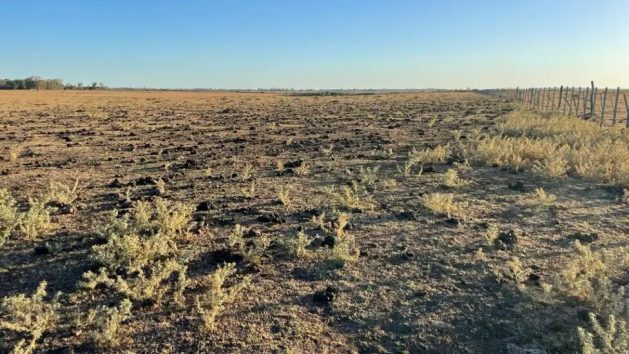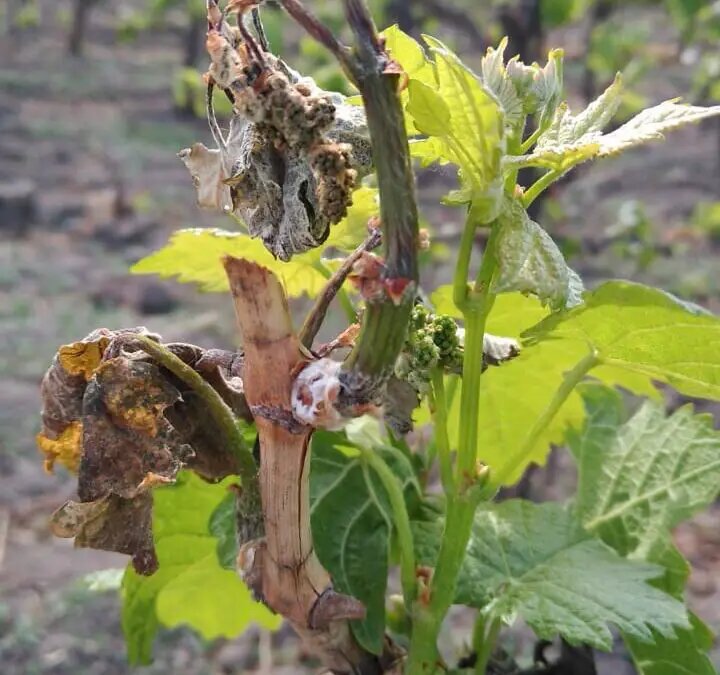Friday, May 3, 2024
News and Views from the Global South
Combating Desertification and Drought
Long, Costly Drought Drives Climate Crisis Home in Argentina

A photo of a field with parched grass in the province of Buenos Aires, an agricultural area par excellence in Argentina. The countryside is the source of more than half of the exports of this South American country, which is in dire need of foreign exchange to ease its economic crisis. CREDIT: Argentine Rural Confederations
- Martín Rapetti, a fourth generation farmer in the province of Corrientes in northeastern Argentina, has already lost more than 30 cows due to lack of food and water, as a result of the long drought that is plaguing a large part of the country. “There is no grass; the animals have to sink their teeth into the dry earth,” he says with resignation.
This extreme climatic phenomenon, which according to experts will become increasingly common, is much more than a threat of an uncertain future and already represents concrete damage: it will make Argentina, a global agricultural powerhouse, lose billions of dollars in exports this year, aggravating its economic crisis.
“The accumulation of three years with little rain makes the situation worse and worse. The streams and rivers are running dry and now the groundwater is also drying up,” Rapetti told IPS from the town of Curuzú Cuatía.
“The cows are in very poor body condition. And the production of grains, citrus fruits and vegetables is suffering…Of the 300 hectares that we have for growing rice, we were able to plant only 35 due to lack of water,” added Rapetti, who has a medium-sized farm.
The consequences go far beyond rural areas because this South American country, which faces a delicate economic situation with inflation soaring to almost 100 percent per year and 40 percent of the population living in poverty, depends heavily on the countryside to bring in foreign exchange and sustain the value of its devalued currency.
During the first half of 2022, according to the latest official data, 57.6 percent of national exports came from the production of soy and the main grains (corn, wheat, sunflower and barley) and from beef and by-products like leather and dairy products.
The drought will reduce exports in 2023 by nearly eight billion dollars and this will have a heavy direct impact on the state coffers, which will receive more than one billion dollars less in taxes on exports of soy, corn and wheat, the three crops that cover the largest agricultural area in the country.
These figures were released on Jan. 17 by the Rosario Stock Exchange, a reference point in Argentina’s agricultural economy.
This South American country of 46.2 million inhabitants depends to a great extent on the countryside to sustain its economy. Argentina is the third world producer of soy, behind the United States and Brazil, and the second producer of beef, according to data from the United Nations Food and Agriculture Organization (FAO).
Soy alone, which is the current star of Argentine exports, generated sales of 12.1 billion dollars (27.3 percent of total exports), according to the official statistics agency. This includes soybeans, soybean oil and meal and soy flour.

A plant in a vineyard suffering from the lack of water, in the province of Mendoza in western Argentina. That area of the country, where crops depend on irrigation, is suffering the consequences of low levels in the reservoirs. CREDIT: Coninagro
How to prepare for the future?
Due to climate change, extreme events such as droughts or floods will occur with increasing frequency and intensity, the national secretary for Climate Change, Sustainable Development and Innovation, Cecilia Nicolini, told IPS.
“But these problems are not scenarios that we have to get used to or resign ourselves to. We need to adapt to their effects and transform our productive sectors to make them more resilient, while reducing their greenhouse gas emissions,” she added.
Argentina presented its National Plan for Adaptation and Mitigation to Climate Change in November.
The over 400-page document proposes managing agroforestry climate risks (from investments in infrastructure or promoting insurance for small farmers), bolstering water efficiency in industries and strengthening the meteorological monitoring network.
“We also have to move forward with actions that go beyond the immediacy and that incorporate a climate perspective. In addition, we need political responses that strengthen our capacities, promote innovation and, ultimately, promote sustainable development,” the official acknowledged.
Perhaps the most delicate aspect is that Nicolini herself estimated that the country needs 185 billion dollars in financing up to 2030 to implement the plan.
That is four times more than the record loan that the International Monetary Fund granted Argentina in 2018, a debt that since then has strangled economic growth. Nobody knows where this financing would come from, which Argentina demanded from developed countries at the last Conference of the Parties (COP27) on Climate Change, held in November in Egypt.

Cows and calves gather in search of food in the department of Curuzú Cuatiá, in the Argentine province of Corrientes. The drought has dragged on for three years now and in 2022 it was the main cause of forest fires, which affected more than 800,000 hectares in that northeastern province. CREDIT: CR
Financial assistance
On Jan. 20 Economy Minister Sergio Massa met with with the Liaison Board, which brings together the main agricultural business chambers, and promised to study a package of economic relief measures to be announced on Feb. 1.
In any case, he warned about the limits that the government faces in providing answers: “Perhaps there are solutions that are out of our hands. Argentina is not a country with a great capacity for State intervention, for reasons that we already know: indebtedness and difficulties in accessing markets.”
Beyond the difficult current situation, today agricultural producers themselves know that fundamental strategies will be needed to face extreme phenomena that are here to stay.
Mario Raiteri, a medium-sized producer of potatoes, beef, wheat, corn, soy and sunflowers in the town of Mechongué, 460 kilometers south of Buenos Aires, tells IPS that he grew up listening to his grandfather talk about the big floods in the 1940s and withering droughts in the 1950s, but that he had never experienced a phenomenon like the one seen in the last three years.
“My biggest worry is if this is just an occasional occurrence or if there really is starting to be a more frequent repetition of these events,” he said.
“In the second case, we need scientific organizations to give us new technologies designed to help us adapt. Knowledge is going to play a very important role, beyond other necessary issues, such as comprehensive agricultural insurance for family farms, because small producers will suffer the most,” he said.
In Argentina, 54.48 percent of the land area has been affected by water stress, according to the Drought Information System for Southern South America (SISSA), an institution created by governments and organizations to provide information and reduce vulnerability to this type of phenomena.
However, hydrologist Juan Borus, deputy manager of Information Systems of the National Water Institute (INA), said that in the last three years “there is not a single square centimeter of the territory that has not faced scarcity.”
Borus warns IPS that the country is currently plagued by dry rivers and lagoons that have shrunk and disappeared, and that the situation is not likely to improve for the remainder of the southern hemisphere summer and the fall.
The expert also warns about the impact on issues that have received less attention than agricultural production. One is the generation of electrical energy due to lack of water in the reservoirs, in a country that has committed to increasing hydropower generation as part of its climate change mitigation objectives.
Another issue is drinking water.
“Large cities on the banks of rivers should invest more money in pumping and purifying the water, because with lower levels of water in the rivers, the amount of pollutants and sediment is greater. And small towns that take water from drilling wells must deal with the decline of groundwater tables,” Borus said.
The crisis, he said, presents a great opportunity: “It is time for those who live in the humid part of the country to become aware of the need to take care of drinking water.”

 Print
Print



